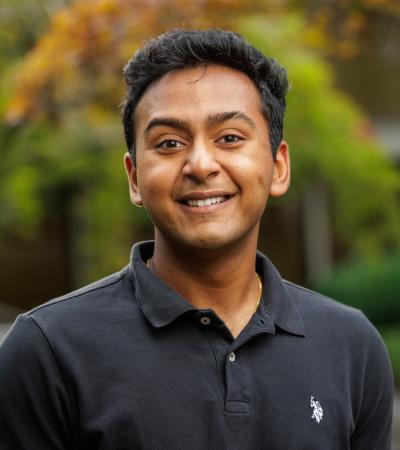Galbraith Through Indian Eyes; Delhi, India
Experiencing the World Fellowship
Adviser: Nikhil Menon
Final Report:
For my project “Galbraith through Indian Eyes,” I examined the ambassadorship of John Kenneth Galbraith in Delhi through the perspective of Indian politicians. In particular, I was curious if Galbraith, who opposed American troops in Vietnam, was able to use India’s chairmanship of a peacekeeping body in Vietnam to conduct trilateral diplomacy. I spent 5 weeks in Delhi, working at the Nehru Memorial Museum and Library (NMML). I went through the papers of Jawaharlal Nehru, VK Krishna Menon (defence minister), and BK Nehru (Ambassador to the US).
My focus was 1961-62, and I was really surprised how tired Nehru was during the period. He was sick, easily tired, and lacking the energy to direct world affairs that defined India's foreign policy during the 1950s. Still, he held onto the Foreign Affairs ministry, limiting any independent diplomatic initiative. During Nehru’s last state visit to the US in 1961, Kennedy repeatedly asked him for advice about Vietnam. Nehru never really responded – partly because he was jetlagged throughout the trip and partly because India was uninterested in South East Asia. A Ministry of External Affairs Memo highlighted the "complete absence of initiative and vigor" of Indian diplomats in South East Asia. Galbraith's ambition to influence Kennedy from Delhi was limited by Indian reluctance and, more importantly, the forces in DC pushing vigorously for hawkishness towards Vietnam. While my hypothesis about Galbraith’s influence on Vietnam proved wrong, the archives revealed that he was a glamorous (ex: during the visit to India of First Lady Jaqueline Kennedy) and influential figure (ex: during China’s invasion of India in 1962).
The experience of working in the archives was a mixed bag. NMML is the premier historical research library in India with a humongous collection of books and important archival material. Initially, the librarians were skeptical of granting access to an undergraduate student. Luckily, Professor Nikhil Menon, whose History of South Asia class got me interested in this area, had written a book based on his research at NMML. Having a signed letter from him proved a lifesaver. After securing my membership, I began to explore the library and the archival reading room. It took me a couple of days to understand library protocol and explore the available collections. The librarians, though particular about procedure, were always helpful and knowledgeable. A few more permission forms later, I finally began reading.
I immediately was struck by the enormity of the archival material. For example, the correspondences of Jawaharlal Nehru run around 300 pages for every month of his tenure. Finding a letter from the American ambassador, let alone a comment about him to an Indian official, was like finding a needle in a haystack. The papers are not indexed, so I spent a significant amount of time just reading every document which was both frustrating and surprisingly informative. Frustrating, because interactions with Galbraith were not only rare, but mostly superficial. The actually revealing statements lie buried in memos written by bureaucrats that did not always make it to the PM’s desk. But, because I had to read everything, I was struck by the diversity of issues he encountered: corruption by members of his party, abuse of power by local officials in a small village, flooding and other disaster relief, election strategy, hunger strikes by regional leaders, worsening border relations with China. I gained an appreciation for the difficulty of the job, but also a deeper understanding of his personality from his responses and private notes.
At times, the archival material was so specific and mundane (ex: the receipt of a cheque for a relief fund), that I had to turn to secondary sources about the topic to understand the surrounding context. These secondary sources, often books only in circulation in India, taught me more than the archival material. I was able to read books about US-India relations, US-China relations, Chinese diplomat Chou Enlai, Singaporean President Lee Kuan Yew, and much more. Some of the books referenced the archival material I had already seen, but good historians added insight and analysis – something I hope to replicate in my own senior thesis.
The biggest challenge of my five weeks in Delhi was certainly the isolation. I usually woke up and headed straight to the archives, where I would work until 5:00 PM. After returning to my Airbnb, I went on a run and had dinner before going to bed. While it was an efficient schedule, there were very few opportunities for social interaction. The archives had other friendly scholars, and chai breaks were a good time to chat with people. But most scholars were much older than me, and it was difficult to form friendships. Unlike the Midwest, talking to strangers in India is frowned upon. So, I kept to myself for most of the month, and the loneliness was challenging. I coped by calling my friends and family every evening and watching a few new TV shows. The highlight of my trip was meeting Ram Guha, the author of the excellent textbook on Indian history that I read all spring semester. Archival work is a solitary slog, and having a few friends or family around can drastically improve the experience.
I left Delhi with a deeper understanding of US-India relations, especially during the cold war. Speaking in Hindi for the entire month, and even reading some archival material in Hindi, improved my fluency. While I enjoyed and learned a lot from the archival work, I also realised that it wasn’t my calling. But during my time in India, I was able to meet several US Foreign Service Officers, and I learned more about the South Asia Bureau of the State Department, where I hope to work after graduation.






